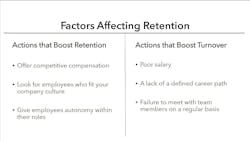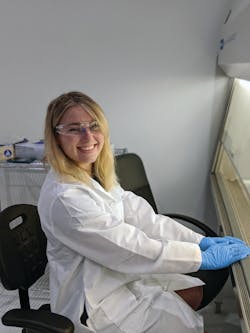While the demand for laboratory technicians and technologists is expected to increase by 7% in the next eight years (not including filling roles of those who retire or voluntarily leave),1 the supply of qualified laboratory professionals will decrease, due in large part to a drop in interest in the field and the number of accredited training programs for medical technologists.2 Any time an employee leaves, the laboratory is impacted by the time commitment to post, interview and hire a new employee, the knowledge loss the exiting employee takes with him or her, the loss of revenue, and the added strain placed on other employees.
For many laboratories, losing qualified employees is simply not an option; however, most do not utilize retention strategies to ensure their employees will stay long term.
Retention starts with ensuring your employees feel like they are valued and trusted members of the team. Understanding your company culture and the type of person you want to hire to add to that culture also is key for retention. Once new employees join the company, you want to ensure you are recognizing them for a job well done, meeting with them frequently to answer any questions, and confirming that any needed additional training is being carried out. Providing a great work environment and benefits are also factors in retaining and engaging your employees. Twenty percent of turnover happens in the first 45 days,3 so it is important to engage and ensure that your new employees feel valued, connected, and invested in the laboratory and their team.
Retention issues occur for many reasons, and having a proper retention strategy is key for any laboratory seeking to hire and keep good employees. Having strong retention at your laboratory means an increase in overall productivity, coinciding with decreases in the time and costs associated with finding, hiring, and training new employees.
Focus on career development
A survey by Deloitte found that lack of career progress topped the list of factors that would cause employees to look for new employment over the next 12 months.4 Millennials overwhelmingly consider career development opportunities to be one of the most important factors they evaluate when considering whether to accept or stay in a position. In another recent study, 49% of employees said that the leadership at their organizations was adhering to the practice of fostering employee development.5
Despite this, however, many laboratories (especially smaller labs of less than 10 people) do not have a proper career path in place. This lack of a defined career path can reflect poorly on employers.
Many small laboratories have not felt a need to create a clear and defined career path. However, because of regulations associated with the Clinical Laboratory Improvement Amendments (CLIA), there are some clear areas laboratories can focus on. For example, in most states, CLIA allows a medical technologist to serve as general supervisor after two years.6 Another career path example is a lead technologist growing into a laboratory manager role, then on to a laboratory operations director. Creating this ladder is the first step in showing your employees that you care about their career development and want them to grow in your laboratory.
After creating this career ladder, it is important to speak with all current employees and create a career map for them. A career map will help you recognize and understand their strengths and weaknesses in the laboratory and will help you decide who is the right fit for each role on your team.
Building a career ladder is also a great opportunity to build job descriptions for each role your laboratory currently has, and to map how “a day in the life” looks. This has the added benefit of being an excellent recruiting tool for you to use with potential hires. Showing a potential hire the typical career path at your lab, as well as a specific job description and day in the life, will give them a full picture of what you expect of them. Additionally, it is imperative to understand the job market and research the job descriptions and salaries being offered by competitors. Many small laboratories have not updated their salaries in several years or potentially have never researched the proper salary for their employees. Reviewing fair pay in your region, and creating a competitive plan around that number, should be something you do every year. This will ensure that your employees are less likely to leave due to poor salaries, and it also creates pay equity across all employees at your laboratory.
Focus on engaging with your employees
Many leaders fall short of truly engaging with their employees and fail to schedule (or keep) regular one-on-ones with their team members. Regularly scheduled individual and group meetings with employees help to establish and remind them of the company’s vision and goals. These meetings also show team members why their work helps the company reach its goals, which at the same time boosts employee morale. When employees see their efforts impact the company in a positive way, they also recognize the value and importance of their work to the company’s overall success.
When employees see leadership truly involved in these efforts to engage and promote their ideas, it helps to promote a sense of unity. This, in turn, encourages employees to perform their jobs well, because they are more invested. Additionally, statistics show that when the leadership is present in the laboratory and providing positive feedback to employees, engagement and morale are also increased. The difference between the performance levels of engaged versus disengaged employees is striking: Engaged employees will outperform disengaged employees by almost 28%.4
The first step to engaging your employees is getting to know them, including their personal and professional interests, backgrounds, and hobbies. If you manage or oversee a larger group of people, it helps to keep notes on important information about them, such as family information, backgrounds, and personal goals. You should meet with your employees one-on-one monthly (at a minimum) to discuss their key performance metrics, as well as any personal or professional goals.
Keep employees informed on how the company is doing and show that you trust them by giving them autonomy within their positions. Allow them to make suggestions and listen to and act on their feedback. Many managers (especially new managers) wrongly believe they need to monitor every move of their employees. However, by providing your employees with autonomy, you will create an organization that is willing to make suggestions and improvements.
Conclusion
There are many steps to creating and maintaining a strong retention strategy, but starting with developing a clear career path, understanding employees’ professional goals, and focusing on employee engagement will help to ensure that your employees have a positive view of your laboratory and that they will want to stay long term. With more than 300,000 clinical laboratory personnel employed in the United States, and an additional 35,000 jobs expected to be added before 2028, it is more crucial than ever that laboratories have a strong retention strategy in place.7
References
- U.S. Bureau of Labor Statistics. Clinical laboratory technologists and technicians: Occupational outlook handbook. https://www.bls.gov/ooh/healthcare/clinical-laboratory-technologists-and-technicians.htm. Updated June 2, 2021. Accessed July 7, 2021.
- Scott K. Solving the clinical laboratory workforce shortage. Clinical Lab Manager. https://www.clinicallabmanager.com/trends/laboratory-staffing/solving-the-clinical-laboratory-workforce-shortage-23189#ref. Published July 6, 2020. Accessed July 6, 2021.
- Hirsch AS. Reducing new employee turnover among emerging adults. SHRM. https://www.shrm.org/resourcesandtools/hr-topics/employee-relations/pages/reducing-new-employee-turnover-among-emerging-adults.aspx. Published June 2, 2016. Accessed July 6, 2021.
- Kwan A, Neveras N, Schwartz J, Pelster B. Talent 2020: Surveying the talent paradox from the employee perspective. Deloitte. https://www2.deloitte.com/content/dam/Deloitte/mx/Documents/about-deloitte/Talent2020_Employee-Perspective.pdf. Published 2012. Accessed July 7, 2021.
- Developing employee career paths and ladders. SHRM. https://www.shrm.org/resourcesandtools/tools-and-samples/toolkits/pages/developingemployeecareerpathsandladders.aspx. Published February 28, 2020. Accessed July 6, 2021.
- Legal Information Institute. 42 CFR § 493.1461 - Standard: General supervisor qualifications. https://www.law.cornell.edu/cfr/text/42/493.1461.Accessed July 6, 2021.
- U.S. Bureau of Labor Statistics. 29-2010 Clinical laboratory technologists and technicians. https://www.bls.gov/oes/current/oes292010.htm#st. Updated March 31, 2021. Accessed July 6, 2021.







